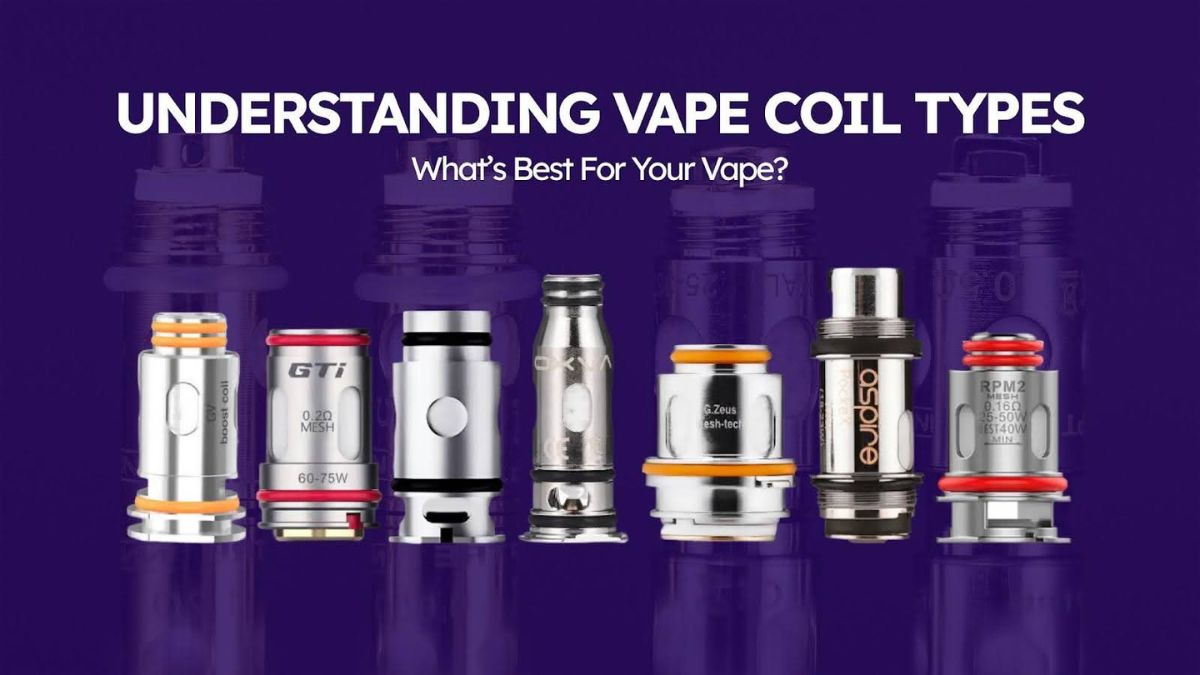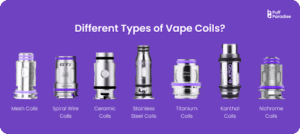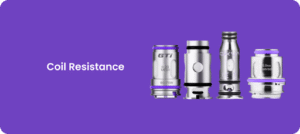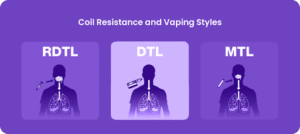TOPIC
Understanding Vape Coil Types: What’s Best for Your Vape

The vape coil serves as the heart of a mod or e-cigarette kit, heating the e-liquid and converting it into vapour. Users can adjust the coil’s resistance based on the number of wire wraps, the gauge, and the type of wire utilised. This resistance is measured using an Ohmmeter. Low-resistance coils generate warmer vapour and more significant clouds, while high-resistance coils create a cooler vape with less current. The coil’s resistance determines which types of e-liquids are suitable for vaping.
Despite its significance, the coil is a relatively simple mechanism. It consists of a coiled wire, a piece of mesh, and a wicking material, typically cotton. Numerous types of cables and wicking materials are available, and the optimal choice will depend on the desired vaping experience of the users. The vape coil is essential for heating e-liquid to produce the vapour inhaled by users. It is a small heating element, typically composed of wire and cotton. When electricity from the battery flows through the wire, it heats up, and the cotton, saturated with e-liquid, absorbs this heat to vapourise the vape juice.
The design and material of the coil can vary, significantly influencing both flavour and vapour production. In a vape device, the coil is generally located within the tank or pod that houses the e-liquid. In tank systems, it is often screwed into the base of the tank, submerged in the e-liquid.
The coil may be integrated into the pod or exist separately in pod systems. Its strategic placement ensures efficient heating of the e-liquid absorbed by the surrounding cotton wick, facilitating even vapourisation.
Coil material
The material used for vape coils can significantly affect users’ vaping experience. Kanthal is a widely preferred choice due to its affordability and durability. It maintains its shape even at high temperatures, making it a reliable option for vapers of all experience levels.
Stainless steel is recognised for its rapid ramp-up time, compatibility with temperature control features, and clean flavour profile. Nickel and titanium coils are primarily utilised in temperature control mode, provided that the device supports this feature. These coils deliver a consistent vaping experience by effectively regulating the coil’s temperature.
Different types of Vape Coil

Several factors must be considered, such as whether users are utilising a pre-made coil or building their own. Some brands offer ceramic and cotton options and occasionally employ other materials, including flax and wood pulp, as wicking materials. Each type affects flavour and cloud production differently. The same principle applies when constructing coils, as various metals possess distinct properties concerning ramp-up time, flavour, and compatibility with different modes.
- Ceramic Coil—Ceramic coils are porous, allowing air to flow through effectively, resulting in a smooth draw. Many reviewers find that ceramic coils enhance flavour more than other materials. They also tolerate high wattages well, making them an excellent choice for high-powered mods. Additionally, ceramic coils are believed to last longer than cotton coils and help prevent dry hits.
- Stainless Steel Coil—There is considerable debate regarding the different grades of stainless steel available, which can create confusion. 430-grade stainless steel wire is known for its magnetic properties and durability. Most stainless steel grades are tough and long-lasting. When building coils, stainless steel is one of the most versatile metals, as it can be utilised in temperature control and wattage modes. With proper care, a stainless steel coil may last up to 25 years.
- Titanium Coil- Titanium wires are soft and malleable, making them easy to handle, twist, and cut. This softness leads to a slightly higher cost than stainless steel; titanium has gained popularity due to its ability to provide a clean and crisp vaping experience. Safety concerns have been raised, as titanium is more flammable than other coil materials (it is used in fireworks to create white sparks). It is compatible only with temperature control mode, necessitating careful temperature management; many mods offer a “TC Ti” mode specifically designed for these coils.
- Kanthal Coil- Kanthal, a combination of iron, chromium, and aluminium, is popular for pre-made and homemade coils. It features a rapid ramp-up time, producing impressive amounts of vapour. However, Kanthal coils are suitable only for wattage mode. They are easy to work with and retain their shape well, making them a favoured option among vapers.
- Nickel Coil—A wide range of nickel wires is available, but users should seek Ni200 wire, which contains 99.6% nickel. Temperature control mods frequently prioritise nickel coils due to their excellent low resistance. However, it is essential not to dry-fire nickel coils for extended periods, as they are incompatible with variable voltage or wattage kits. Additionally, some individuals may have an allergy to nickel, similar to allergies some experience with nickel jewellery.
- Nichrome Coil- Nichrome comprises 80% chromium and 20% nickel. This alloy heats up significantly faster than Kanthal, providing reliable cloud production and a pleasantly warm vape. It also protects the heating element from oxidation, which can affect the colour and taste of e-liquid. Nichrome coils can only be used in wattage mode. This and their quick ramp-up time make them popular among sub-ohm vapers.
- Mesh Coil- Mesh coils, such as QUAQ Mesh Coils, have transformed the vaping experience for many users. Unlike traditional wire coils, mesh coils feature a larger surface area, allowing for simultaneous vapourisation of more e-liquid. This results in richer and more intense flavours, whether users prefer fruity, dessert, or tobacco-inspired options.
- Vape Coils and Ohms- The Ohm level measures electrical resistance, influencing flavour and cloud production. When constructing coils, measuring the resistance with an Ohmmeter is crucial for safety and to ensure the desired vaping experience.
- Sub Ohm Coil- A lower resistance produces warmer vapour, a slightly drier hit, and larger clouds. However, the downside is that e-liquid consumption increases rapidly, and higher wattage is typically required for optimal performance.
In addition to enhanced flavour profiles, one of the standout features of mesh coils is their consistent vapour production. The unique design ensures even heat distribution across the coil, eliminating the risk of dry hits—an issue commonly associated with traditional wire coils. As a result, vapers, whether beginners or experienced enthusiasts, can expect a reliable and satisfying experience every time.
Coil resistance

Coil resistance, measured in ohms, is crucial to the vape device’s performance. This resistance determines the level of opposition the coil presents against the electrical current from the battery, directly impacting the amount of heat generated during activation.
- High Ohm Coils (High Resistance)- Coils with a resistance of 1.0Ω or higher are categorised as high-resistance coils. These coils permit less electrical flow, resulting in lower temperatures and cooler vapour with a more subtle flavour. They are well-suited for users who prefer a smoother, gentler vaping experience.
- Low Ohm Coils (Low Resistance)- Coils with a resistance of less than 1.0Ω are referred to as sub-ohm coils. These coils allow greater electrical flow, enabling them to heat to higher temperatures. They are favoured by users who seek to produce large clouds of vapour and enjoy more robust flavours.
Coil Resistance and Vaping Styles

The resistance of vape coils plays a crucial role in defining users’ vaping styles. Different resistance ranges cater to distinct vaping preferences, each offering a unique experience:
- Mouth-to-lung (MTL) vaping—This style mimics traditional cigarette smoking, where vapour is drawn into the mouth before being inhaled into the lungs. Ideal coil resistance for MTL vaping falls between 1.2Ω and 0.8Ω, providing a tighter draw that allows for a more controlled and flavourful vape.
- Restricted Direct to Lung (RDL) Vaping- RDL vaping sits between MTL and Direct to Lung (DTL) styles, utilising coils with a resistance of 0.7Ω to 0.5Ω. This method offers ammoderately loose draw, balancing flavour intensity with vapour production.
- Direct-to-lung (DTL) vaping—For those seeking an intense, cloud-heavy experience, DTL is the preferred method. This technique involves inhaling vapour directly into the lungs. Coils with a resistance below 0.4Ω facilitate an open draw, resulting in large vapour clouds and rich flavour.
Coil Resistance and E-Liquids

Understanding coil resistance is essential for selecting appropriate e-liquids to pair with them.
- E-Liquids for Mouth-to-Lung Vaping – When using coils ranging from 1.2Ω to 0.8Ω for MTL vaping, both nicotine salts and freebase nicotine e-liquids are excellent options:
- Nicotine Salts – These nicotine salts are ideal for MTL vaping as they provide a smoother throat hit at higher nicotine levels, making them suitable for those transitioning from traditional smoking.
- Freebase Nicotine E-Liquids—Known for delivering a stronger throat hit, these e-liquids are ideal for users who prefer a more intense sensation.
- E-Liquids for Restricted Direct-to-Lung Vaping- For RDL vaping, which employs coils with a resistance between 0.7Ω and 0.5Ω, freebase nicotine e-liquids prove to be the preferred choice:
- Strong Throat Hit- The slightly looser draw associated with RDL vaping complements the pronounced throat hit of freebase nicotine, enhancing the overall experience.
- Enhanced Vapour Production—These coils are designed to generate more vapour, while freebase nicotine e-liquids support this capability by being suitable for higher wattages, boosting vapour output.
- Rich flavour Delivery- The heat generated by RDL coils enhances the flavours in freebase nicotine e-liquids, delivering a fuller and more satisfying taste.
- E-Liquids for Direct-to-Lung Vaping- DTL vaping, which utilises coils below 0.4Ω, pairs effectively with short-fill e-liquids for several reasons:
- Suitability for Low Resistance- Shortfills, characterised by their higher VG content, are well-suited for the intense vapour production required in DTL setups, resulting in thick, dense clouds.
- Customizable Nicotine Levels- These e-liquids allow users to add nicotine shots according to their preferences, making them ideal for DTL vaping, where lower nicotine strengths are often favoured due to the intensity of the experience.
- Enhanced flavour, Cloudflavour, and cloud production are essential aspects of the DTL style.
Not all vape coils are compatible with every vape device. To ensure a safe and enjoyable vaping experience, users must select a coil that matches their device’s specifications. Users should consider the manufacturer’s recommended wattage range, coil resistance, and device compatibility. A device that features Automatic Coil Detection automatically adjusts the wattage based on the coil’s resistance, ensuring optimal flavour and vapour production.
Personal vaping preferences significantly influence the choice of coil. For those who enjoy direct-to-lung (DTL) vaping, which produces large clouds and intense flavour, low-resistance sub-ohm coils are typically the best option. Conversely, for users who prefer a more discreet, cigarette-like experience, higher-resistance coils are ideal for mouth-to-lung (MTL) vaping.
In addition to resistance and material, users should also consider the coil’s design and wicking material, as these factors can impact both flavour and vapour production. By understanding their vaping style and preferences, users can customise their vaping experience to suit their tastes and maximise the enjoyment of their e-cigarette devices and favourite e-liquids.
Final Thoughts on Vape Coils
Understanding how to select the appropriate vape coil is essential for achieving an optimal vaping experience. Whether users prioritise dense vapour, bold flavour, or a smooth throat hit, the right coil can significantly impact the outcome. Low-resistance coils cater to cloud chasers, while higher-resistance options provide a cigarette-like draw, making them suitable for individuals who prefer a mouth-to-lung (MTL) vaping style. Moreover, coil materials such as mesh or stainless steel can enhance flavour delivery and longevity.
Proper maintenance of coils—such as priming them before use and replacing them regularly—ensures consistent performance and prevents dry hits or a burnt taste. The choice of coil should align with users’ vaping styles, device specifications, and preferred e-liquid compositions. By experimenting with various options, users can fine-tune their setups for the most enjoyable and satisfying vaping sessions.
TOPIC
Top Strategies for Success in Pokedle: Tips from the Pros

Introduction to Pokedle
Welcome to the vibrant world of Pokedle, where strategy meets fun in an exhilarating adventure! If you’re new to this captivating game or looking to sharpen your skills, you’re in for a treat. Pokedle combines elements of exploration and competition that keep players coming back for more. With its unique creatures and challenging battles, it’s no wonder that fans are eager to uncover what makes this game so addictive.
Whether you aim to become a top contender or just want to enjoy the gameplay with friends, mastering the nuances of Pokedle is essential. In this blog post, we’ll explore some tried-and-true strategies from seasoned players that can elevate your gaming experience. Let’s dive into the essentials and unlock your potential as a true Pokedle master!
Understanding the Basics: Types, Elements, and Moves
Pokedle is a vibrant world filled with diverse creatures, each possessing unique abilities. Understanding the different types of Pokedle is crucial for effective gameplay. There are elemental categories like Fire, Water, Grass, and Electric. Each element has strengths and weaknesses that can turn the tide in battles.
Elements determine how Pokedle interact during combat. For example, Water-type moves are super effective against Fire-types but weak against Electric-types. Knowing these interactions will help you make strategic decisions.
Moves play a significant role too. Every Pokedle can learn various attacks. Some may deal heavy damage while others focus on status effects like paralysis or sleep.
Understanding these components creates a solid foundation for any aspiring trainer looking to excel in the game and build powerful strategies around their team composition.
Building Your Team: Choosing the Right Pokedle for You
Choosing the right Pokedle is crucial for your success. Each type comes with its strengths and weaknesses. Assess what fits your play style best.
Consider the elemental types first. Water, fire, grass—each element has unique advantages in battles. Think about how they might counter opponents’ choices.
Next, evaluate movesets. Some Pokedles excel at dealing damage while others focus on support or defense strategies. A balanced team often yields better results.
Don’t forget about synergy between team members. Combining different elements can create powerful combinations that catch opponents off guard.
Experimentation is key here. Try multiple configurations to discover which Pokedles resonate with you personally and enhance your gameplay experience.
A well-rounded team tailored to your preferences sets the stage for victory in every match you encounter on this thrilling journey.
Training and Evolving Your Pokedle
Training your Pokedle is essential for unlocking its full potential. Each Pokedle has unique traits and abilities that can be enhanced through proper training methods.
Start with daily battles to gain experience points. The more you battle, the stronger your Pokedle becomes. Pay attention to its moves; some are best suited for offensive strategies while others excel in defense.
Evolving your Pokedle opens new avenues of gameplay. To evolve effectively, focus on leveling up through various challenges and quests. Certain items may also trigger evolution, so keep an eye out for those valuable resources.
Don’t forget about friendship levels! Some Pokedles evolve when they reach a high bond with you. Spend quality time together by participating in mini-games or simply exploring new areas side by side.
Balancing these elements will help shape a formidable team ready for any challenge ahead.
Battling Techniques: Using Strategy and Tactics
In Pokedle, battles are not just about raw power. Strategy and tactics play a crucial role in securing victory. Understanding your opponent’s weaknesses gives you an edge.
Timing is essential when executing moves. Knowing when to attack or defend can turn the tide in your favor. A well-timed move may catch your opponent off guard, leading to unexpected outcomes.
Positioning matters too. Placing your Pokedle correctly on the battlefield maximizes its abilities while minimizing damage taken from foes. Always be aware of both yours and your enemy’s positioning.
Using status effects can disrupt opponents’ strategies effectively. Inflicting paralysis or sleep might give you that critical moment needed for a decisive blow.
Stay adaptable during battles. If a strategy falters, don’t hesitate to switch gears and try something new based on real-time observations of the battle flow.
Tips from Professional Players
Professional players emphasize the importance of understanding your Pokedle’s strengths and weaknesses. Each type has its own advantages, so knowing them can turn the tide in battles.
Timing is crucial. Pro players often recommend practicing with different moves to find the best moment to strike. Patience can lead to perfect execution when it counts.
Another tip is to analyze your opponent’s strategy during a match. Observing their patterns allows you to anticipate their next move, giving you an edge in tight situations.
Team synergy cannot be overlooked either. Pros suggest building a well-rounded team that complements each member’s abilities for maximum effectiveness.
Never underestimate practice sessions. Regular training helps refine techniques and boosts confidence when facing real opponents in competitive scenarios.
Conclusion: Mastering Pokedle for Victory
Mastering Pokedle takes dedication, strategy, and a deep understanding of the game’s mechanics. By grasping the various types and elements of Pokedle, players can build strong teams that complement each other. Training your Pokedle effectively ensures they reach their full potential.
Utilizing smart battling techniques allows you to turn the tide in challenging matches. Learning from seasoned professionals will provide insights that can elevate your gameplay significantly.
As you navigate this journey, keep experimenting with different strategies and approaches. The world of Pokedle is vast and exciting, waiting for you to explore its depths. With persistence and passion, victory in Pokedle is well within your reach. Embrace the adventure wholeheartedly!
TOPIC
Why the 404 Area Code is More Than Just a Dialing Prefix for Atlantans

The 404 area code isn’t just a series of numbers—it’s a symbol of identity, culture, and community for Atlantans. When you hear that familiar dialing prefix, it evokes images of bustling streets, rich history, and vibrant neighborhoods. But there’s so much more to this area code than meets the eye. From its intriguing past to its present-day significance in technology and business, the 404 area code is woven into the fabric of Atlanta life. Join us as we explore what makes this iconic number a true representation of everything that makes Atlanta special.
The History of the 404 Area Code
The 404 area code was established in 1947, making it one of the original area codes assigned by AT&T. It initially covered a vast region, including much of Georgia and parts of Alabama.
As Atlanta grew rapidly during the mid-20th century, so did its need for more telephone numbers. The city blossomed into a major cultural and economic hub, prompting the creation of additional area codes over time.
By 1992, as population density increased further, the neighboring 678 and later 470 codes emerged to accommodate demand. Despite these changes, the nostalgia attached to the original 404 remains strong among longtime residents.
The early days of this area code were characterized by rotary phones and party lines—a far cry from today’s instant connectivity. Yet that history laid down roots that still resonate with Atlantans who cherish their city’s rich past.
The Expansion of the 404 Area Code
The 404 area code was established in 1947, covering just a small section of Georgia. Initially, it served only the Atlanta metropolitan area. As the city grew, so did its need for more communication channels.
By the mid-1990s, rapid population growth and technological advancements put pressure on this single area code. New areas were emerging across Greater Atlanta, leading to an expansion that affected local residents and businesses alike.
In response to increasing demand, officials introduced new codes like 678 and later 470. These additions helped ease congestion but also marked a shift in how people identified with their regional codes.
Despite these changes, many Atlantans still hold onto their original 404 numbers with pride. It’s become a badge of honor—a connection to the heart of Georgia’s vibrant culture and history amidst all that transformation.
What Makes the 404 Area Code Unique
The 404 area code is more than just a series of numbers. It carries the spirit and vibrancy of Atlanta, Georgia. This code originally encompassed the entire state but has evolved to represent the heart of the city.
Its uniqueness lies in its rich cultural tapestry. The 404 symbolizes a blend of history, music, and innovation that defines Atlanta’s identity. From hip-hop legends to culinary pioneers, this area code has nurtured iconic figures.
Moreover, it stands out through community pride. Locals proudly claim their connection to the 404 as part of their identity. It’s not uncommon to see “404” emblazoned on clothing or merchandise as a badge of honor.
In a world where many places share similar area codes, 404 serves as an emblem for Atlantan resilience and creativity—qualities that continue to shape the city’s narrative today.
Famous Companies and Landmarks Associated with the 404 Area Code
The 404 area code is a badge of honor for Atlanta, home to numerous iconic companies and landmarks. Coca-Cola’s global headquarters sits proudly in the heart of downtown. This renowned beverage giant has shaped not only the city but also international culture.
Another notable company is Delta Air Lines, headquartered near Hartsfield-Jackson Atlanta International Airport. As one of the largest airlines globally, its presence emphasizes Atlanta’s role as a major transportation hub.
Landmarks like the Georgia Aquarium and Centennial Olympic Park define the city’s skyline and draw millions each year. The aquarium is one of the largest in the world, showcasing marine life from every ocean.
Ponce City Market offers a bustling mix of shops and eateries within a historic structure that once served as a Sears warehouse. These elements make up an ecosystem where innovation meets tradition in this vibrant city represented by its beloved 404 area code.
How the 404 Area Code Reflects Atlanta’s Culture and Identity
The 404 area code is more than just numbers; it embodies the spirit of Atlanta. This city thrives on diversity, and the 404 captures that essence perfectly.
From hip-hop to Southern cuisine, every corner reflects a unique blend of cultures. The vibrant art scene showcases local talents while paying homage to history.
Community pride runs deep here. Residents often refer to themselves as “404” natives, creating an unbreakable bond among them.
This identity is also evident in local businesses and startups that call Atlanta home. Their innovative approaches mirror the city’s dynamic character and forward-thinking mindset.
Even sports teams tap into this cultural identity, rallying fans around shared experiences tied to the area code. It’s not just about geography; it’s about belonging and connection in every call made within its boundaries.
The Impact of Technology on the 404 Area Code
Technology has reshaped the landscape of communication within the 404 area code.
With the rise of smartphones, landlines are becoming relics of the past. Many residents now rely solely on mobile devices for their daily interactions.
VoIP services have also gained traction. This shift allows users to bypass traditional phone lines entirely while maintaining a local Atlanta presence. Businesses benefit from this flexibility, creating virtual offices that resonate with their clientele.
Moreover, social media platforms enable faster connections among locals and businesses alike. The 404 area code is more than just a number; it’s an online community hub where ideas and cultures flourish.
Emerging technologies like AI-driven customer service tools enhance efficiency for companies in Atlanta’s vibrant market. Such innovations reflect not only local growth but also a dynamic adaptation to global trends.
Conclusion
The 404 area code is more than just a series of numbers. It represents the spirit and resilience of Atlanta. This dialing prefix has become a symbol of identity for locals, connecting them to their city’s rich history and vibrant culture.
As technology continues to evolve, so does the way we use area codes. The 404 area code remains central in an age where digital communication often outweighs traditional phone calls. Its significance will likely endure as new generations adopt it as part of their local heritage.
Understanding the meaning behind the 404 area code gives insight into Atlanta’s past and present. Whether you’re visiting or living there, this iconic number carries stories that resonate deeply with those who call it home. The heart of Atlanta beats within these digits, making them a vital part of what connects people to each other and their surroundings.
Embracing what the 404 area code stands for enriches our appreciation for this bustling metropolis. So next time you hear someone mention it, remember—it’s not just about dialing; it’s about belonging to something greater than oneself in one of America’s most dynamic cities.
TOPIC
Biking Quads in Nature: The Best Trails and Scenic Routes to Explore

Introduction to Biking in Nature
Picture this: the sun shining down, a gentle breeze rustling through the trees, and the thrill of adventure at your fingertips. Biking quads in nature offers a unique opportunity to explore breathtaking landscapes while getting a solid workout. Whether you’re navigating winding trails or cruising along scenic routes, each ride brings its own sense of freedom and excitement.
Biking is more than just an outdoor activity; it’s a chance to reconnect with nature, escape from daily stresses, and enjoy some fresh air. As you pedal your way through stunning vistas and lush greenery, you’ll discover hidden gems that only two wheels can reveal. So grab your helmet and gear up—it’s time to hit the trails!
Benefits of Biking for Health and the Environment
Biking quads offers a delightful way to enhance your physical health. It strengthens muscles, boosts cardiovascular fitness, and improves joint mobility. Plus, it can elevate your mood through the release of endorphins.
Nature provides the perfect backdrop for this activity. Riding outdoors exposes you to fresh air and sunlight, which are essential for mental well-being. The rhythmic motion of pedaling can also reduce stress levels.
From an environmental perspective, biking is a sustainable choice. By opting for two wheels over four, you help decrease carbon emissions and lower traffic congestion.
Every ride contributes to less noise pollution as well. This creates a more peaceful environment not just for yourself but also for wildlife and other outdoor enthusiasts.
Incorporating biking into your routine promotes a healthier lifestyle while nurturing our planet’s ecosystems in the process.
How to Prepare for a Biking Adventure
Preparing for a biking adventure starts with choosing the right bike. Ensure your quad is in top shape; check the brakes, tires, and gears before hitting the trails.
Next, consider your route. Research local trails that suit your skill level and desired scenery. Familiarize yourself with any elevation changes or challenging terrain.
Pack smartly by bringing essential gear such as a helmet, water bottle, snacks, and basic repair tools like a tire pump or multi-tool. A small first aid kit can be invaluable too.
Dress appropriately based on weather conditions and trail demands. Breathable layers work well for fluctuating temperatures while sturdy shoes provide better traction.
Let someone know your plans before you set off on your adventure. This adds an extra layer of safety to your outing!
Top Trails and Scenic Routes for Biking Quads
For those eager to hit the trails, there are countless paths that cater specifically to biking quads. One standout is the Moab Brand Trails in Utah. Its stunning red rock landscapes provide a breathtaking backdrop as you navigate winding routes.
In California, the Tahoe Rim Trail offers both challenge and beauty. With panoramic views of Lake Tahoe, it’s an experience that combines adrenaline with nature’s splendor.
The Kingdom Trails in Vermont should not be overlooked either. This network boasts diverse terrain and lush greenery that invigorates every ride.
Head over to Colorado for the Monarch Crest Trail, where high-altitude paths deliver thrilling descents alongside alpine vistas.
Each of these locations promises unique scenery while catering to bikers of varying skill levels—perfect for weekend getaways or extended adventures in nature’s embrace.
Tips for Staying Safe While Biking in Nature
Staying safe while biking quads in nature is essential for an enjoyable experience. Always wear a properly fitted helmet to protect your head from any unexpected falls or collisions.
Check your bike before hitting the trails. Ensure that brakes function well and tires are inflated correctly. A well-maintained bike reduces the risk of accidents.
Stay aware of your surroundings. Watch for pedestrians, wildlife, and other cyclists on shared paths. Being alert helps you react swiftly to any potential hazards.
Plan your route ahead of time and share it with someone who isn’t going with you. This way, someone knows where you’ll be if anything goes wrong.
Carry a basic first-aid kit and hydration supplies during longer rides. Staying hydrated keeps energy levels up, allowing you to focus on safety rather than fatigue.
Ride within your skill level and don’t hesitate to walk your bike through particularly challenging areas or steep descents.
The Importance of Responsible Trail Use and Leave No Trace Principles
Responsible trail use is essential for preserving the beauty of our natural environments. Each time you hit the trails on your biking quads, remember that you’re sharing these spaces with wildlife and fellow outdoor enthusiasts.
Following Leave No Trace principles helps minimize your impact. Stick to established paths to avoid damaging vegetation and soil. When taking breaks, choose durable surfaces like rocks or picnic areas rather than creating new spots in fragile ecosystems.
Proper waste disposal is crucial as well. Carry out whatever you bring in, including food scraps and wrappers. Consider using biodegradable options when possible.
Moreover, respecting wildlife habitats ensures that animals can thrive without unnecessary disturbances. Observing creatures from a distance allows everyone to enjoy nature’s wonders while protecting their homes.
By embracing these practices, we ensure future generations can experience the same joy biking quads brings us today.
Conclusion: Get Out and Explore on Two Wheels!
Biking quads in nature offers an unparalleled experience that combines adventure, health benefits, and eco-friendliness. It’s a chance to reconnect with the great outdoors while getting some exercise. As you explore various trails and scenic routes, you’ll not only enjoy breathtaking views but also boost your physical fitness.
Preparing for your biking adventure is crucial. Make sure you’re equipped with the right gear and know the trail conditions before heading out. Staying safe is equally important—always wear a helmet and be aware of your surroundings to avoid hazards.
Respecting nature should guide every ride. Embracing Leave No Trace principles ensures that our beloved trails remain pristine for future generations of bikers and outdoor enthusiasts.
So why wait? Grab your bike, hit those trails, and discover what nature has to offer on two wheels! Whether it’s a leisurely ride or an exhilarating journey through rugged terrain, each pedal stroke brings new sights and experiences waiting just around the corner.
-

 TECHNOLOGY5 months ago
TECHNOLOGY5 months agoTop 10 Must-Read Stories from Kristen Archives You Can’t Miss
-

 TECHNOLOGY11 months ago
TECHNOLOGY11 months agoSky Bri Net Worth Revealed: How She Built Her Financial Empire
-

 TOPIC1 year ago
TOPIC1 year agoBasement Renovation Contractors: How They Tackle Structural Issues During Renovations
-

 TOPIC8 months ago
TOPIC8 months ago5 Reasons the //Vital-Mag.Net Blog Dominates Lifestyle
-

 TOPIC6 months ago
TOPIC6 months agoTop 10 Articles from the ://Vital-Mag.net Blog That You Can’t Miss
-

 CRYPTO9 months ago
CRYPTO9 months agoCrypto30x.com Review: Is It the Right Platform for You?
-

 BUSINESS5 months ago
BUSINESS5 months agoTraceLoans Explained What You Need to Know
-

 ENTERTAINMENT3 months ago
ENTERTAINMENT3 months agoNHentai.NEF: Navigating the Popular Hentai Archive with Ease
